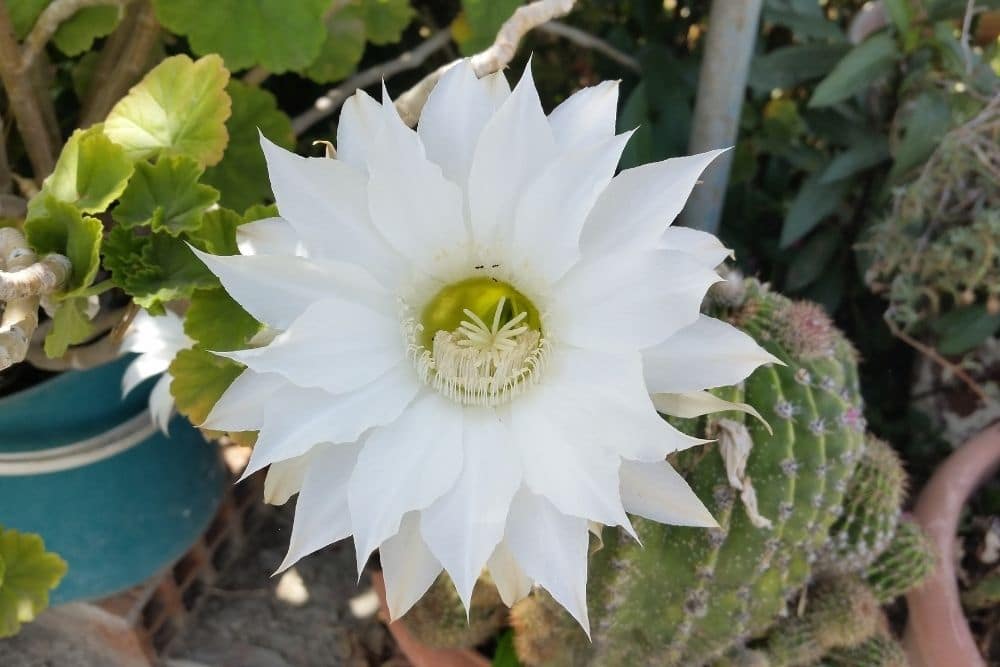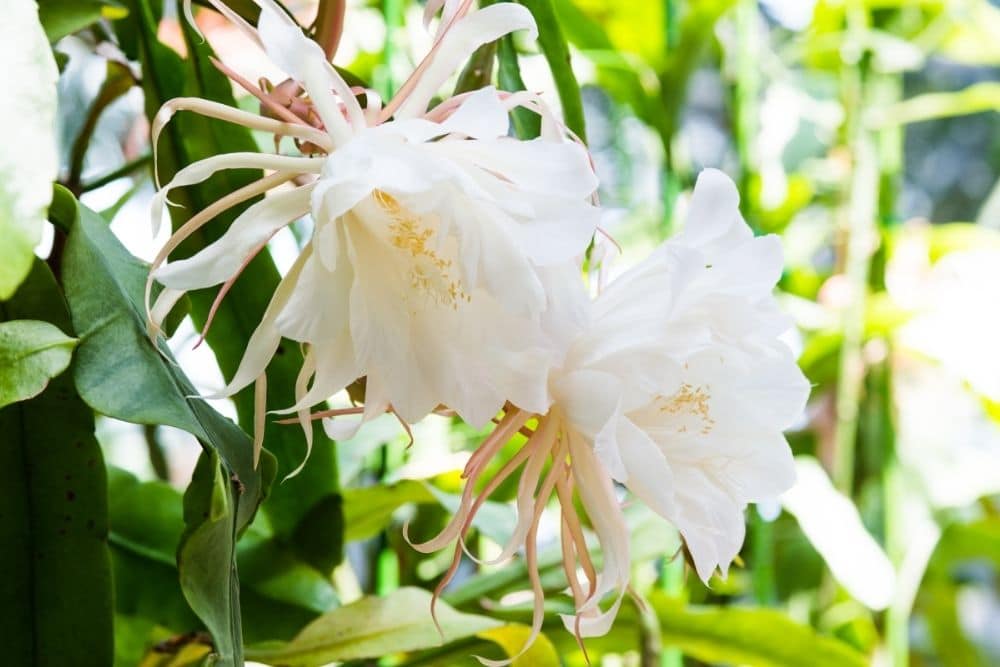Flower Glossary is reader-supported. When you buy through links on our site, we may earn an affiliate commission.
The Epiphyllum Oxypetalum, also referred to as the Queen of the Night or the Dutchman’s Pipe Cactus, blooms only at night. This plant has a strong, sweet smell that attracts pollinators.
Native to Mexico and South America, this plant thrives in hardy zones 10 to 11 and can grow up to 10 feet tall. If kept in cooler zones, it can live indoors as a houseplant.

The Epiphyllum Oxypetalum has white flowers that bloom only at night, typically after 8 pm. Although they may remain open until around 10 am the following morning, it isn’t uncommon for these flowers to wilt before sunrise. Uniquely, only one flower will bloom each night.
Growing a Queen of the Night flower isn’t overly challenging, however, you must allow it some time to bloom. It will also require some effort on your behalf to make sure that it is properly maintained and thriving.
Below, we have compiled the ultimate guide that will inform you of everything that you need to know in regards to growing and caring for this beautiful flower.
Table of Contents
Growing and Caring for the Queen of the Night
This plant can be grown indoors or outdoors, but there are a few factors that you should be aware of when attempting to grow a Queen of the Night plant. If it is not kept in the correct environment it isn’t going to thrive.
Location
First, you must choose the best place to position your plant. If it is going to be kept indoors it should be placed in a bright area where it isn’t exposed to direct sunlight.
Although a small amount of sunlight isn’t going to be hugely harmful to the plant, too much exposure can cause it to become scorched.
If your plant is going to be kept outdoors, ideally, you should plant it inside a pot or a container as you can then move it to different areas of your garden as and when required.
In regards to exposure to sunlight, the same rules apply. Try and keep your plant in partial shade, where it is out of the way of direct sunlight.
Soil
Understanding the soil requirements of your plant is of utmost importance as it can greatly impact how well the plant grows and blooms.
Unlike the majority of other species of cactus plants, the Queen of the Night needs to be planted in a moist but airy soil that is slightly acidic. Due to the nature of the soil in the climates where it typically grows, you shouldn’t let it completely dry out in between waterings.
Unfortunately, if the soil that it is planted in dries out, your Queen of the Night plant will die. A soil that effectively drains the excess water away from the roots is recommended.
If you are uncertain as to which type of soil is best for your Queen of the Night plant, you can ask for help at your local gardening store as they will be able to point you in the right direction.
Light Requirements
In its natural habitat, this plant grows in shaded areas. As such, you want to replicate this in the environment where you plant it. Whilst they do require access to some sunshine to bloom, as previously stated, this should be indirect sunlight.
Managing the plant’s exposure to sunlight outdoors can be quite a challenge, especially if it is planted into the ground, hence why it is recommended that you plant it in a container.
A queen of the night that has been planted directly into the ground will benefit from the addition of an umbrella or bed sheet. The addition of such accessories will absorb the intensity of the sunlight, ultimately helping to protect the plant.
Tolerance to Frost
As a cactus species, this plant has a low tolerance to freezing temperatures. This should be expected because, in its native habitat, the Queen of the Night is accustomed to a humid climate.
If you live in a cold area, you should bring this plant indoors when the cold temperatures hit, making sure that you do not position it right by a window. Those that are planted directly into the ground are going to be much harder to move in the colder weather.
In this case, you should cover your plant when you are expecting the temperatures to drop. You can either make your own structure or you can cover the plant with a cloth or a blanket, ensuring that they are not in direct contact.
Water
Your plant will struggle to survive if it is not watered properly, however, because it is succulent it doesn’t need a lot of moisture. Overwatering your Queen of the Night can cause it to rot. Hydration is required when the soil starts to dry out.
Generally, it is recommended that you allow the top layer of soil to dry out before giving it any more water. Use warm water to water your plant when it is blooming because this will ensure that it does not become shocked.
The climate in which you live will determine the regularity in which you water your plant. Those living in drier climates will need to water the plant more often. During the summer, you will likely need to water this plant once a week. During the winter, you will need to decrease the frequency.
Instead of watering it once every week, you should only water it once every 2 to 3 weeks. Remember to judge how much water your plant needs by the climate of the location that you live in.
Humidity and Temperature
Remember that this plant originates from a tropical location. Because of this, during the winter, you will need to replicate similar, steady levels of humidity. To increase the humidity, you can spray the plants or introduce an artificial humidifier.
Feeding the Plant
If the soil is too nutritious it can affect how well the plant blooms. For this reason, you must avoid using the fertilizer every time that you water your plant. You can use a liquid fertilizer or create your own homemade version.
Pests
Just like many other plants, the Queen of the Night can be affected by pests. The main signs of a pest problem include fungal leaf spots. If your plant has been affected by plants, you will need to cut away the section that has been affected.

How to get the Queen of the Night to bloom
As we have mentioned, getting this plant to bloom can be quite a challenge. Because this plant only blooms at night, some may not even witness it bloom for the duration of time that they are growing it.
As the Queen of the Night blooms, it releases a sweet, noticeable scent. If you want to see whether your plant is blooming, you will need to check it at night. Your plant has the best opportunity to bloom when it is planted in a controlled environment.
The process will also require effort on your behalf as it isn’t going to be an immediate process but one that takes time. Ensure that you regulate the temperature and growing conditions as the temperature changes. You may find that your plant blooms the best during the rainy summer periods.
Propagating a Queen of the Night plant
Propagating a Queen of the Night plant is a straightforward process. You can propagate your plant using large or small leaf cuttings. Take your cutting and dip a very small section of it into a rooting hormone.
After doing so, you will then need to set the cutting aside and allow it time to dry out before planting it in the soil. Make sure that the pot in which you plant the cuttings is sufficiently sized as you don’t want it to be too big. Keep the container away from sunlight and do not water immediately.
Final Thoughts
Growing and caring for a Queen of the Night plant isn’t an overly challenging task providing that their requirements are met.
It is important to make sure that it is planted in the correct type of soil and positioned away from direct sunlight. Aside from this, you must maintain the levels of humidity that this plant is used to.
Also, make sure that you pay closer attention to it when the temperatures begin to drop. Witnessing a Queen of the Night bloom may be a rarity but this remains to be a beautiful plant.
